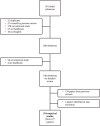The Role of Qualitative Research Methods in Discrete Choice Experiments
- PMID: 28061040
- PMCID: PMC5367554
- DOI: 10.1177/0272989X16683934
The Role of Qualitative Research Methods in Discrete Choice Experiments
Abstract
Background: The use of qualitative research (QR) methods is recommended as good practice in discrete choice experiments (DCEs). This study investigated the use and reporting of QR to inform the design and/or interpretation of healthcare-related DCEs and explored the perceived usefulness of such methods.
Methods: DCEs were identified from a systematic search of the MEDLINE database. Studies were classified by the quantity of QR reported (none, basic, or extensive). Authors ( n = 91) of papers reporting the use of QR were invited to complete an online survey eliciting their views about using the methods.
Results: A total of 254 healthcare DCEs were included in the review; of these, 111 (44%) did not report using any qualitative methods; 114 (45%) reported "basic" information; and 29 (11%) reported or cited "extensive" use of qualitative methods. Studies reporting the use of qualitative methods used them to select attributes and/or levels ( n = 95; 66%) and/or pilot the DCE survey ( n = 26; 18%). Popular qualitative methods included focus groups ( n = 63; 44%) and interviews ( n = 109; 76%). Forty-four studies (31%) reported the analytical approach, with content ( n = 10; 7%) and framework analysis ( n = 5; 4%) most commonly reported. The survey identified that all responding authors ( n = 50; 100%) found that qualitative methods added value to their DCE study, but many ( n = 22; 44%) reported that journals were uninterested in the reporting of QR results.
Conclusions: Despite recommendations that QR methods be used alongside DCEs, the use of QR methods is not consistently reported. The lack of reporting risks the inference that QR methods are of little use in DCE research, contradicting practitioners' assessments. Explicit guidelines would enable more clarity and consistency in reporting, and journals should facilitate such reporting via online supplementary materials.
Keywords: discrete choice experiment; qualitative research; survey; systematic review.
Conflict of interest statement
The authors have no financial conflicts of interests.
Figures



References
-
- Naik Panvelkar P, Armour C, Saini B. Community pharmacy-based asthma services—what do patients prefer? J Asthma. 2010;47:1085–93. - PubMed
-
- Lancaster KJ. A new approach to consumer theory. J Polit Econ. 1966;74:132–57.
-
- McFadden D. Conditional logit analysis of qualitative choice behaviour. In: Zarembka P, ed. Frontiers in Econometrics. New York: Academic Press; 1974. p 105–42.
-
- Hensher D. An exploratory analysis of the effect of numbers of choice sets in designed choice experiments: an airline choice application. J Air Transp Manag. 2001;7:373–9.
-
- Smyth RL, Watzin MC, Manning RE. Investigating public preferences for managing Lake Champlain using a choice experiment. J Environ Manage. 2009;90:615–23. - PubMed
Publication types
MeSH terms
LinkOut - more resources
Full Text Sources
Other Literature Sources

